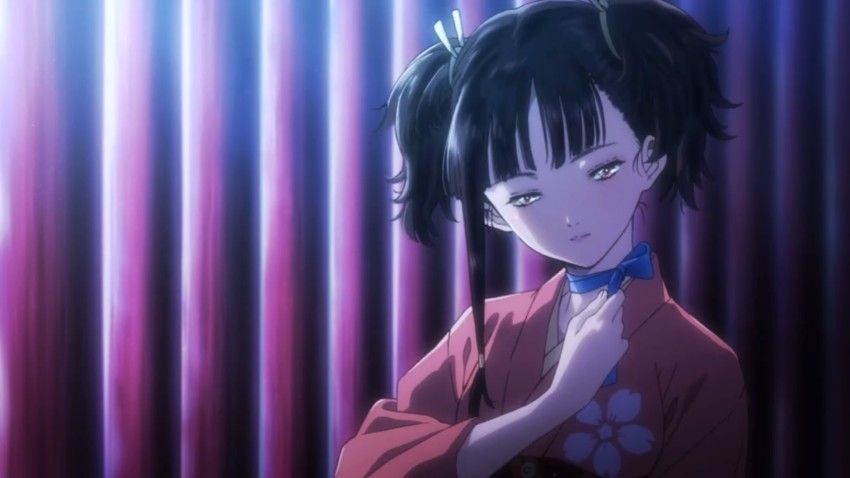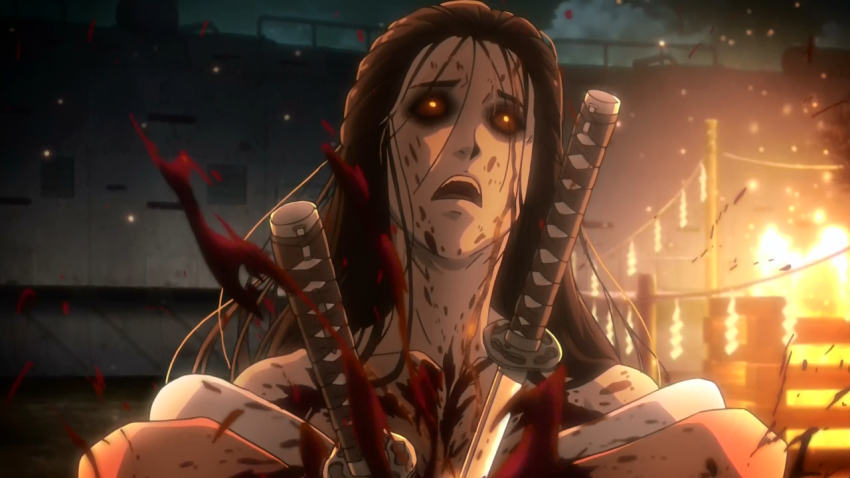Kabaneri of the Iron Fortress
December 18, 2018 · 1 comment
By Andrew Osmond.
 Kabaneri of the Iron Fortress was first broadcast as a 12-part serial in Japan last year, on Fuji TV’s prestigious “Noitamina” slot. It was subsequently shunted into a specially edited two-part cinema edition, with new scenes at the beginning and end – and because the original series only ran for 12 parts, the film edition only had to trim a small proportion of the story to make everything fit.
Kabaneri of the Iron Fortress was first broadcast as a 12-part serial in Japan last year, on Fuji TV’s prestigious “Noitamina” slot. It was subsequently shunted into a specially edited two-part cinema edition, with new scenes at the beginning and end – and because the original series only ran for 12 parts, the film edition only had to trim a small proportion of the story to make everything fit.
Many, perhaps most, anime are clear straight off about what kind of anime they’re going to be. Kabaneri is an exemplar. It’s a horror-action saga starring the most familiar fast-food monsters of twenty-first century horror, flesh-eating zombies. It’s by the director and studio that brought you Attack on Titan, and often feels so close to Titan that it might be an “alternate world” spinoff. Yes, Kabaneri seems just as eager to satiate fan tastes as its zombies – here called Kabane – are carnally driven to satisfy theirs.
Of course the details have been varied a bit. First, the Kabane are human-sized, not Titan giants. But forget the sad, pathetic, lurching old-school Romero zombies. The Kabane can sprint, they have internal armour shielding their hearts, and some of them have combat and strategy skills. As in standard zombie films, if they bite you, that dooms you to become a Kabane, too… though it’s suggested there may be exceptions to that rule. Nonetheless, people with Kabane injuries are swiftly executed, or else told to kill themselves with a body-destroying explosive. If anyone wants to start a controversy about the show hiding dangerous messages, you could point out how Kabaneri revives the old Japanese tradition of honourable suicide.
Kabaneri’s setting could be described as Japanese steampunk. In contrast to the Germanic walled towns in Attack on Titan, Kabaneri is set on the island of Hinomoto… which happens to be another pronunciation of the kanji characters used in the name of Japan. Both the human and natural scenery are clearly Japanese, as the Kabane are fought by samurai – yes, Hinomoto looks like period Japan, before the country modernised in the nineteenth century.
But then there are the giant trains. In this world, the humans travel on steam-driven metal juggernauts, with blades instead of cow-catchers, spattered with the blood of Kabane who get in the way. The human towns are linked together by the railway network, which gives the citizens some chance of escape if a town is overrun by Kabane. That’s what happens in the first scenes, where the Kabane invade by the simple expedient of smashing a train into a town wall at high speed. (Presumably no Colossal Titans were available.)
 As most people rush for the train, the Kabane are held back by two fighters: Mumei, a young girl with phenomenal fighting prowess, and Ikoma, a young boy desperate to avenge a female relative. By now, the parallels with Titan are outrageous, and the show’s makers know it – some of the scenes play like luridly over-the-top Titan parodies. Wait until you see the kind of violence that the girl metes out on the boy, and try not to think of Titan’s Mikasa.
As most people rush for the train, the Kabane are held back by two fighters: Mumei, a young girl with phenomenal fighting prowess, and Ikoma, a young boy desperate to avenge a female relative. By now, the parallels with Titan are outrageous, and the show’s makers know it – some of the scenes play like luridly over-the-top Titan parodies. Wait until you see the kind of violence that the girl metes out on the boy, and try not to think of Titan’s Mikasa.
As we mentioned, the show was made by Studio WIT, the same studio as Attack on Titan. It has the same feeling of grand, glossy spectacle, even with obvious shortcuts. The swarms of Kabane sometimes look like crude cut-outs, and there are static frames here and there. But as Jacob Chapman of Anime News Network points out, Kabaneri’s palette is far brighter, more anime than Titan. The costumes alone are livid enough for a Final Fantasy game. (‘Original Character Design’ is credited to Haruhiko Mikimoto, who had the same credit on Gunbuster and Macross.) Beyond costumes, look out for an early battle where the kick-ass Mumei takes on a Kaban in a tunnel of blood-crimson tori gates, modelled on the famous Inari shrine in Kyoto.
The director is Tetsuro Araki, probably best known by this generation for Death Note, but has more recently handled both the quasi-zombie titans of Attack on Titan and the “real” zombies of High School of the Dead. Series composition and screenplay are credited to Ichiro Okouchi, who created Code Geass, another fantasy about an “occupied” version of Japan. However, there’s a separate script credit for Hiroshi Seko, who was the show-runner on two other horror anime, Ajin and Seraph of the End. He also co-wrote the steampunk horror film Empire of Corpses and – very notably – sixteen episodes of Attack on Titan.
The vision of giant trains in Kabaneri may owe something to the early scenes in Hayao Miyazaki’s 1986 film Laputa, which feature ginormous military trains. It’s also an interesting coincidence that Studio Wit plumped for a “trains versus zombies” months before the massively successful release of Train to Busan, a live-action South Korean film using the same concept.
The original Kabaneri anime won in five categories at the Newtype Anime Awards, including Best TV Anime, Best Soundtrack, Best Character Design, Best Screenplay and Best Studio.
Kabaneri of the Iron Fortress is released in the UK by Manga Entertainment.
Yualexius
December 31, 2018 2:00 pm
Well, at first I thought it's just another Attack on Titan wanna-be that's why I didn't watch it imediately and I actually regretted it. The animation is pretty similar, no question there since they're both made by the same studio as Attack on Titan. Though, zombie-like theme story had been the cliche this century even in the West. Nonetheless, as you had mentioned Kabaneri mixed the zombie-like theme to some of the well-established Japanese traditions and setting. Overall, it's a great adventure to follow, with astounding animation and vivid fight scenes that really makes the ride even more exciting and intense.